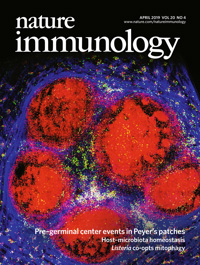- EN - English
- CN - 中文
Evaluation of B Cell Proliferation in vivo by EdU Incorporation Assay
通过EdU掺入法评估体内B细胞增殖
发布: 2020年05月05日第10卷第9期 DOI: 10.21769/BioProtoc.3602 浏览次数: 6629
评审: Meenal SinhaJason A. NeidlemanAnonymous reviewer(s)

相关实验方案

研究免疫调控血管功能的新实验方法:小鼠主动脉与T淋巴细胞或巨噬细胞的共培养
Taylor C. Kress [...] Eric J. Belin de Chantemèle
2025年09月05日 3445 阅读

外周血中细胞外囊泡的分离与分析方法:红细胞、内皮细胞及血小板来源的细胞外囊泡
Bhawani Yasassri Alvitigala [...] Lallindra Viranjan Gooneratne
2025年11月05日 1328 阅读
Abstract
Generation of antibodies is crucial for establishing enduring protection from invading pathogens, as well as for maintaining homeostasis with commensal bacteria at mucosal surfaces. Chronic exposure to microbiota- and dietary- derived antigens results in continuous production of antibody producing cells within the Peyer’s patch germinal center structures. Recently, we have shown that B cells responding to gut-derived antigens colonize the subepithelial dome (SED) in Peyer’s patches and rapidly proliferate independently of their relative BCR affinity. To evaluate B cell proliferation within different niches in Peyer’s patches, we applied in vivo EdU incorporation assay as described in this protocol.
Background
Long-lived antibody producing cells, also known as plasmablasts or plasma cells (PCs) primarily originate from germinal centers (GCs), microanatomical sites that form within lymphoid organs following infection or immunization. Entry into the GC reaction involves affinity-based competition of B cells, each expressing an antigen-specific B cell receptor (BCR) with a given affinity and specificity towards the antigen. Upon antigen encounter, B cell activation takes place, which is accompanied by extensive clonal expansion through rapid proliferation. Peyer’s patches (PPs) are lymphoid organs located along the small intestine and are the main site where B cells class switch their immunoglobulins to IgA. The subepithelial dome (SED) is a small niche within the PP wherein immune cells, including B cells, interact with gut-derived antigens. During pre-GC events in PPs, B cells bearing high affinity BCRs do not show preferential advantage in colonization of the SED and formation of PCs, indicating that affinity-based competition does not take place at this site (Biram et al., 2019). Nonetheless, only high affinity clones progress into the GC structures and enter the germinal center reaction. Massive proliferation is a major aspect of the GC reaction in peripheral lymph nodes, spleen and PPs (Victora and Nussenzweig, 2012). During the GC response, B cells undergo iterative cycles of migration between the dark zone (DZ), where they proliferate and mutate their antibody-encoding genes and the light zone (LZ), where the high affinity varaiants are selected by T follicular helper (Tfh) cells for preferential expansion and differentiation into plasma cells. B cells in the GC rapidly divide, and the magnitude of this proliferation is proportional to the strength of T cell help (Gitlin, Shulman and Nussenzweig, 2014). Although B cell proliferation can be induced in vitro by LPS and anti-IgM stimulation, analysis of GC B cell proliferation in culture is currently not possible. In particular, analysis of B cell proliferation in specialized immunological niches such as the SED, can be only examined in vivo.
There are various techniques to measure cell proliferation, which are based on the detection of DNA synthesis, cellular metabolism or proliferation-associated proteins. Cellular metabolism markers such as MTT, XTT and WST-1 assays provide an indirect measurement of cell proliferation and can be inaccurate or in some cases toxic to cells (Liu et al., 1997; Huang et al., 2004). The use of proliferation proteins is a more common and widely used technique and includes staining for Ki67, PCNA and MCM-2 proteins (Bologna-Molina et al., 2013; Carreón-Burciaga et al., 2015). DNA synthesis-based techniques including BrdU, EdU, IdU and CIdU rely on the incorporation of these nucleoside analogs into newly formed DNA strands. As for EdU, the nucleoside incorporation is detected by a click reaction that involves a copper-catalyzed azide-alkyne cycloaddition. DNA replication occurs during S-phase and at this stage, nucleosides are being integrated into the newly formed DNA. Cell cycle progression towards G2/M-phase involves an increase in DNA content. The combination of EdU administration with DNA content staining, which discriminates G1, S and G2/M cells, allows the analysis of proliferation in the different cell-cycle stages. Unlike proliferation-associated protein measurement, DNA synthesis-based measurement, which involves injection of nucleosides into mice, can capture the dynamics of proliferation according to the time allowed for the nucleoside to incorporate into the DNA (Ouadah et al., 2019). In addition, combination of more than one analog, followed by analog-specific detection may provide information on cell populations at different cell cycle stages and on the rate of transition between the stages. Such a method was implemented to study how the magnitude of T cell help affects the speed of the cell cycle within the GC response (Gitlin et al., 2014). Therefore, EdU and other analogs are the preferred method for quantification of proliferating cells within the germinal center. Here, we provide details for EdU incorporation measurement by flow cytometry of B cells in different compartments within the gut associated lymphoid organs. This protocol can be easily adapted to analyze cell proliferation in other experimental systems.
Materials and Reagents
- BD Micro-FineTM Plus 0.5 ml 30 G insulin syringe (BD, catalog number: 230-45094 )
- Sterile Syringe 3 ml, luer lock (MedHarmony, catalog number: 181110 )
- MonojectTM 18 G blunted cannula (Covidien, catalog number: 8881202348 )
- Cell strainer with a 70 µm pore size (SPL, catalog number: 93070 )
- 5 ml polystyrene round-bottom tube with a cell strainer cap (Falcon, catalog number: 352235 )
- 8-week old C57BL/6 wild-type mice (Envigo)
- 5-ethynyl-2’-deoxyuridine (EdU) (Thermo Fisher Scientific, Invitrogen, catalog number: E10187 )
- Bovine serum albumin (BSA), fraction V (MP, catalog number: 160069 )
- Click-iTTM Plus EdU Alexa FluorTM 647 Flow Cytometry Assay Kit (Thermo Fisher Scientific, Invitrogen, catalog number: C10634 )
- TruStain FcXTM (anti-mouse CD16/32) Antibody (Biolegend, clone: 93, catalog number: 101319 )
- V500 anti-mouse B220 (CD45R) antibody (BD, clone: RA3-6B2, catalog number: 561226 )
- Brilliant violet 605 anti-mouse CD138 (Syndecan-1) antibody (Biolegend, clone: 281-2, catalog number: 142515 )
- PE-Cy7 anti-mouse CD95 (FAS) antibody (BD, clone: Jo2, catalog number: 557653 )
- Alexa Fluor 700 anti-mouse CD38 antibody (eBioscience by Thermo Fisher Scientific, clone: 90, catalog number: 56-0381-82 )
- Biotin anti-mouse IgA antibody (Biolegend, clone: RMA-1, catalog number: 407003 ). Detected with Streptavidin APC-Alexa Flour 780 (eBioscience by Thermo Fisher Scientific, catalog number: 47-4317-82 )
- Brilliant violet 421 anti-mouse CD196 (CCR6) antibody (BD, clone: 140706, catalog number: 564736 )
- Phosphate buffered saline (PBS) (Biological Industries, catalog number: 02-023-1A )
- 1% BSA PBS (see Recipes)
- EdU solution (see Recipes)
Equipment
- Dry bath incubator
- Analitical balance
- Rocking shaker
- Curved scissors (FST, catalog number: 14091-09 )
- CytoFlex flow cytometer (Beckman Coulter)
Software
- FlowJo software (LLC)
Procedure
文章信息
版权信息
© 2020 The Authors; exclusive licensee Bio-protocol LLC.
如何引用
Biram, A. and Shulman, Z. (2020). Evaluation of B Cell Proliferation in vivo by EdU Incorporation Assay. Bio-protocol 10(9): e3602. DOI: 10.21769/BioProtoc.3602.
分类
免疫学 > 免疫细胞功能 > 淋巴细胞
免疫学 > 动物模型 > 小鼠
细胞生物学 > 基于细胞的分析方法 > 流式细胞术
您对这篇实验方法有问题吗?
在此处发布您的问题,我们将邀请本文作者来回答。同时,我们会将您的问题发布到Bio-protocol Exchange,以便寻求社区成员的帮助。
Share
Bluesky
X
Copy link










